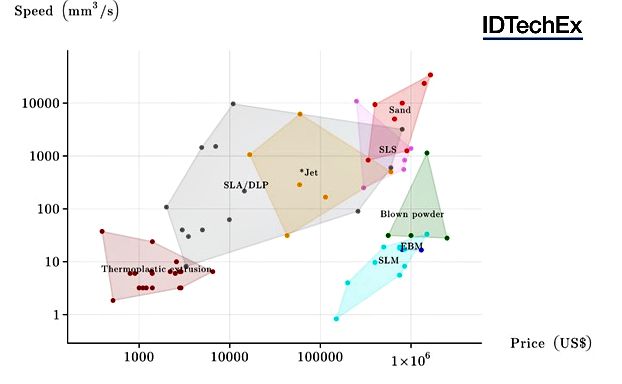
3D Crystal Ball Gazing
By IDTechEx director — Dr. Jon Harrop
Automation 3D printing 3D Printing 2015-2025: Technologies IDTechEx Markets PlayersVisualizing the 3D printing landscape 2015-2025 by IDTechEx.
The 3D printing industry is still going from strength to strength. According to the IDTechEx report “3D Printing 2015-2025: Technologies, Markets, Players”, this industry is set to grow from $1-billion in 2012 to $20-billion in 2025. This growth is due to both improvements in existing printing technologies and the development of completely new technologies. Keeping track of these developments is a challenge.
IDTechEx has been tracking the 3D printing industry for years by attending events and interviewing major players. All of the information is collated in comprehensive databases of manufacturers, service bureaus and printers. The database is regularly updated and provides a solid foundation for assessing the current state of the market as well as forecasting how things will change in the future. In particular, it is easy to identify key differentiators between technologies and vendors using this information. However, it is not always easy to analyze or visualize the data so we have adopted some novel techniques to help.
In the case of printers the database provides detailed quantitative information on technology type, build volume, build speed, precision, machine price and so on for hundreds of different machines ranging from consumer-level products to high-end industrial manufacturing for aerospace. Common forms of analysis such as principal component analysis (PCA), a machine learning algorithm, can be used to study the data in order to spot interesting features such as key differentiators in terms of characteristics such as speed and price or combinations thereof. There are also many different ways to visualize this data.
Our favorite approach to visualizing data entails choosing a pair of axes, such as price and build speed, and plotting each printer as a dot colored according to its technology type. The regions of the price-speed plane occupied by different technologies may then be highlighted by drawing the convex hull that surrounds the points for each technology in its color. Due to the huge variations in all characteristics, log scales are used throughout.
The following figure shows one such diagram for price vs speed:
The diagram above shows immediately the regions occupied by the different 3D printing technologies with thermoplastic extrusion in the bottom left hand corner (low price and low speed) to sand printing at the top right (high price and high speed) and selective laser melting of metals in the bottom right (high price and low speed).
The plastic printing technologies (thermoplastic extrusion, SLA/SLP, *Jet and SLS) offering increasing speed with increasing price starting with thermoplastic extrusion and going through SLA/DLP and jetting to SLS. For plastic printers, the price vs speed tradeoff is the single biggest key differentiator between the products on the market.
In contrast, metal printers vary greatly in terms of speed but vary relatively little in terms of price. Specifically, speeds range from 1 to 3,000mm³/s whereas prices range from $150,000 to $3-million. When it comes to metal 3D printers, price is clearly not the main differentiator.
In terms of progress in 3D printing technologies, the upper left quadrant represents printers that are both cheap and fast. This is clearly sparsely populated today. Several players are pushing into this region including Carbon3D’s high speed vat photopolymerisation and HP’s high speed Multijet Fusion.
Similar diagrams for all combinations of price, speed, precision and build volume along with comprehensive study are provided in the IDTechEx report “3D Printing: 2015-2025: Technologies, Markets, Players”.
About IDTechEx
IDTechEx guides strategic business decisions through its Research and Events services, helping customers profit from emerging technologies. It provides independent research, business intelligence and advice to companies across the value chain based on its core research activities and methodologies providing data sought by business leaders, strategists and emerging technology scouts to aid their business decisions. Learn more at www.IDTechEx.com or contact them via e-mail at research@IDTechEx.com.
Advertisement


